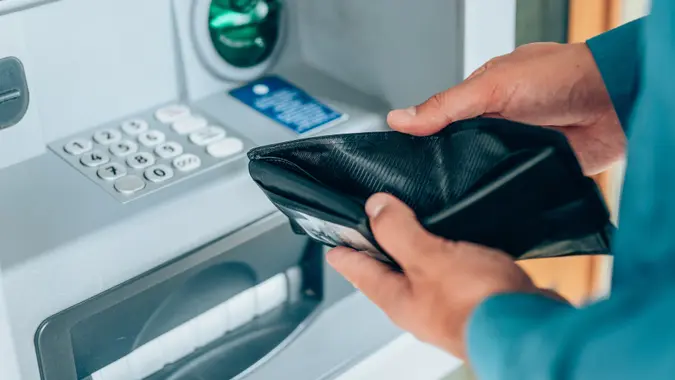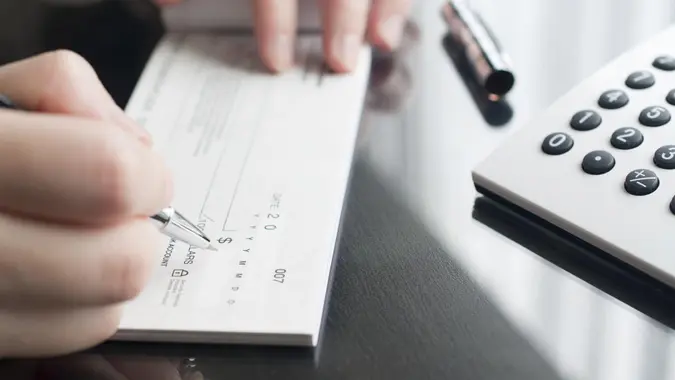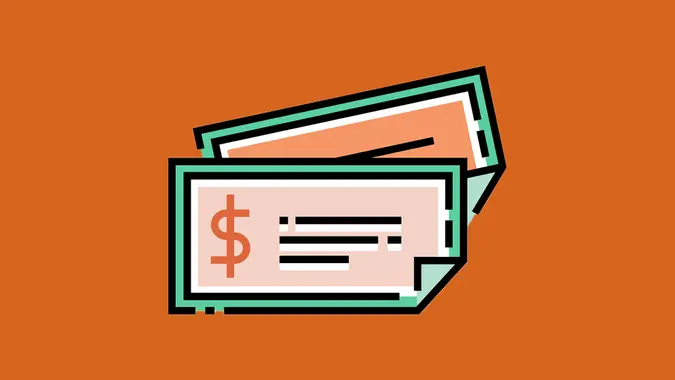What Is ACH Direct Deposit?

Commitment to Our Readers
GOBankingRates' editorial team is committed to bringing you unbiased reviews and information. We use data-driven methodologies to evaluate financial products and services - our reviews and ratings are not influenced by advertisers. You can read more about our editorial guidelines and our products and services review methodology.

20 Years
Helping You Live Richer

Reviewed
by Experts

Trusted by
Millions of Readers
Gone are the days of rushing to your bank to make sure you can deposit or cash your paper check. Now, it can all be electronically transferred instantaneously. So what are these magical wire transfers, and how do they work?
ACH, or automated clearinghouse, is a nationwide network. It allows financial institutions to send each other money.
Types of ACH Deposits
There are two types of ACH deposits: credit and debit.
Debit transfers include:
- Mortgages
- Utility bill payments
Credit transfers include:
- Direct deposits from your employer
- Tax refunds
- Government benefits (social security, etc.)
- Mortgage payments
Payment apps like Venmo and PayPal also use ACH to quickly transfer money from you to your friends.
How Long Does an ACH Deposit Take?
ACH used to take one to three days to process. But the Federal Reserve and Nacha, or the National Automated Clearing House Association, have been working to expand Same Day ACH. Now, payments of up to $1 million can be received in a few hours.
Factors that affect timing
Nacha estimates that 80% of ACH payments are settled in one banking day or less. However, each bank has its own processing time. Some banks may process ACH deposits faster than others. Weekends and bank holidays can also slow processing.
Tips for Faster Deposits
The ACH has a processing schedule that affects how quickly money is moved. The schedule is different for each type of transaction. For example, for Same Day Eligible items, if the data for the transfer is received by 10:30 am ET, then the money should be in the receiver’s account by 1:00 PM ET on the same day.
Submitting your requests as early as possible will help your process go through as fast as possible.
Benefits of ACH Deposits
ACH deposits have many benefits for business and people:
- Safer than a regular wire transfer
- Some payments can be reversed
- Usually no fees to send or receive money
- Good way to pay bills on time
How to Set Up an ACH Deposit
To make an ACH deposit, you’ll have to gather some information from the person or organization receiving the money, including:
- Name
- Bank name
- Type of account
- Account number
- Bank routing number
After that, follow the instructions from your bank or other financial institution you’re making the payment through.
ACH Deposit vs. Wire Transfer: What’s the Difference?
Wire transfers are another way to electronically transfer money. However there are some important differences. Unlike ACH deposits, wire transfers:
- Often come with expensive fees
- Cannot be canceled
- Come with a higher risk of fraud
Sometimes wire transfers can be faster than ACH deposits. However, if your deposit qualifies for Same Day ACH, the ACH may be faster.
Common Issues with ACH Deposits
Although ACH deposits can be a convenient way to send and receive money, there are some things to consider:
- You need to have either a checking or savings account
- Some banks limit the amount of money you can transfer per day or month
- Cut-off times for same-day transactions can extend how long it will take for you to receive funds
- If the organization doesn’t store your information correctly, your bank account details can be leaked.
Can You Cancel an ACH Deposit
You can reverse or cancel ACH deposits, but they must follow certain rules. According to Nacha, you can reverse:
- Duplicate payments
- Incorrect payments
- Payments sent to the wrong account
- A credit payment processed too late
- A debit payment processed too early
If the deposit doesn’t fall under these scenarios, it can’t be reversed. For example, you can’t reverse a payment because you don’t have enough money in your account.
How Safe Are ACH Deposits?
ACH deposits are very safe. They have a lower instance of fraud than other payment methods like paper checks or wire transfers.
When you receive an ACH deposit from a business for the first time, Nacha requires that they verify your information. This can prevent errors that will slow down deposits.
One potential downside of ACH is that if a business doesn’t store your bank account information correctly, it can be vulnerable to data leaks. Companies like Plaid can help businesses encrypt your information and keep it more secure.
The Bottom Line
ACH direct deposits have changed the landscape of how people, employers and government agencies send and receive money. A majority of the workforce now gets their paycheck via direct deposit, allowing them to get funds faster and not have to deal with banking hours of operation or physical checks.
Eventually, ACH direct deposits will probably get even faster and more secure than they are now. They will probably also have better integration with digital wallets like Apple and Google Pay.
FAQ
Here are the answers to frequently asked questions about ACH direct deposits.- What does ACH mean on a deposit?
- ACH stands for automated clearing house, and it refers to direct deposits or electronic fund transfers being made through banks or credit unions.
- Is ACH deposit a direct deposit?
- Yes, an ACH deposit is an electronically transferred fund that is directly deposited into your checking or savings account. Examples of ACH direct deposits include salary payments from your employer, tax refund payments from the Federal Reserve or government benefits.
- What is the difference between direct deposit and ACH?
- The difference between direct deposit and ACH transfers is that direct deposits are transfers into your checking or savings account in the form of tax payments, government benefits or payroll, whereas ACH transfers are processed through the Automated Clearing House Network and are more bank-to-bank fund transfers.
- How long does an ACH deposit take?
- ACH deposits, on average, take one to three business days to fully appear in the receiving checking or savings account.
Emily Gadd contributed to the reporting of this article.
Our in-house research team and on-site financial experts work together to create content that’s accurate, impartial, and up to date. We fact-check every single statistic, quote and fact using trusted primary resources to make sure the information we provide is correct. You can learn more about GOBankingRates’ processes and standards in our editorial policy.
- The Federal Reserve. "Automated Clearinghouse Servic"
- Nacha. "How ACH Payments Work."
- FRB Services. "FedACH® Processing Schedule"
- Nacha. "Same Day ACH"
- Nacha. "Reversals."
 Written by
Written by  Edited by
Edited by 
























